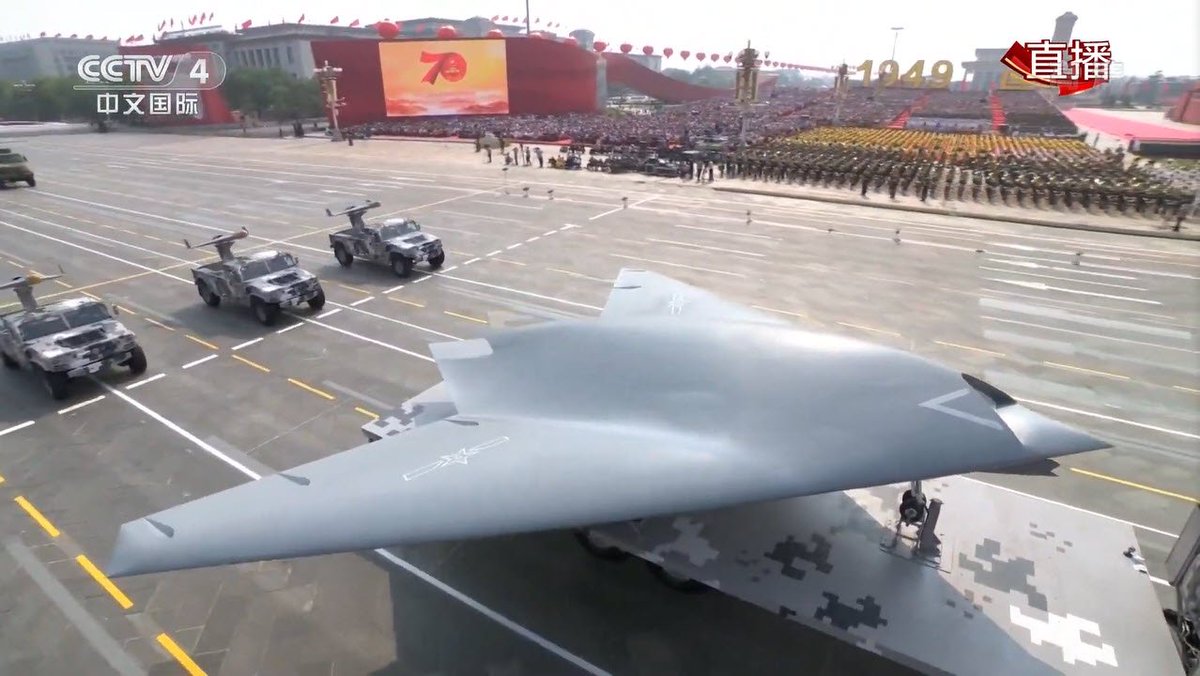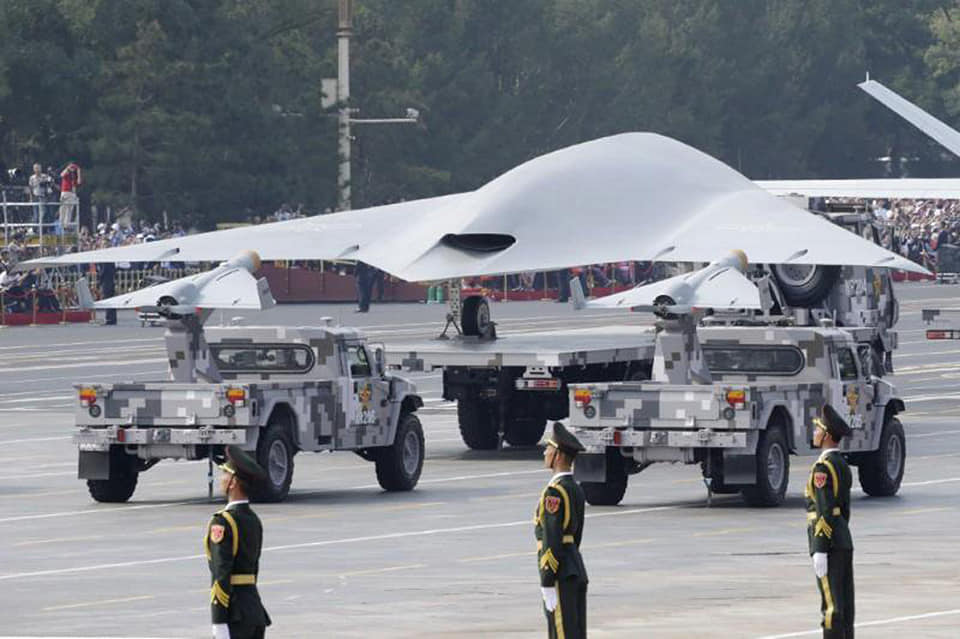A video doing the rounds on the internet shows what appears to be a naval variant of the Chinese GJ-11 ‘Sharp Sword’ stealth drone deploying decoys to zero in on a pair of surface warships.
Overhyped! Why China’s ‘Much Touted’ J-20 Jets, Despite New Engine & BVR Missile, Cannot End F-35’s Dominance?
Bangladesh Looks To Buy Eurofighter Typhoons, Sideline Rafale Fighter Jets Due To India Factor – Expert
The clip shared online bears the logo of the state-owned China Central Television Channel (CCTV-7). While it did not show the complete video that had been released by the state-run Aviation Industry Corporation of China (AVIC) during the Zhuhai airshow, it reflected the Chinese defense industry’s efforts to broaden the types of drones technologies they plan to field.
AVIC’s subsidiary, Hongdu Aviation Industry Group, has developed the Gongji-11 (GJ-11).
The video begins with one of the supposed GJ-11 derivatives taking off from the deck of what appears to be a Type 075 amphibious assault ship. This newly inducted ship that entered the PLA Navy (PLAN) service earlier this year, is seen as a major milestone for them.
Promotional video for the shipborne version of the GJ-11 drone shown by the AVIC at the China Air Show. pic.twitter.com/RDw8COgPAA
— 彩云香江 (@louischeung_hk) October 7, 2021
Two more of these assault ships are already at different stages of construction now. It is expected that the PLAN will eventually acquire a fleet of at least eight of these ships in the near future.
The UCAVs like this GJ-11 were previously shown to be only taking off from the decks of China’s fleet of supercarriers.
Straight From Science Fiction, US To Equip Its Military With High-Energy Laser Guns For Next-Gen Warfare
Japanese Version Of F-16 Fighter Aircraft Loses Its Cockpit Canopy Mid-Air While Chasing An Intruding Jet
Dissecting The The Footage
Resembling a scene from a futuristic war film, the group of six decoys deployed from the UCAV fly in a formation hovering near two enemy warships. A missile is fired from the enemy warship at the decoys. Eventually, the footage ends with the drones swarming and beaming some airwaves at the enemy ships.

These swarming decoy drones are observed to have an uncanny resemblance to Raytheon’s ADM-160 Miniature Air-Launched Decoy (MALD) series. To add more to this shared resemblances observed in the Chinese footage is the concept of the decoys morphing into a “ghost” aircraft as a visual representation of the false signatures decoys could give off.
The US ADM-160 MALD is a low-cost, expendable, air-launched craft that can deceive the most advanced air defense systems while keeping pilots and aircraft out of harm’s way. Their programmable weapon can duplicate the combat flight profiles and signatures of the US and allied aircraft.

The aircraft signature that the Chinese displayed in the footage might depict a naval variant of the Chinese FC-31 stealth fighter. Whether this Shenyang FC-31 stealth fighter has a naval variant is still not officially confirmed but a mockup of it has been spotted four months back.
Moreover, the networked pattern of beams these drones were shown projecting in the last few seconds of the video is could be a directed-energy weapon or signal jammers.
As F-35 Goes Nuclear, Is Lockheed Martin On Course To Arm US’ Stealth Jets With Hypersonic Missiles?
As India Opens Up Space, How ISRO Could Help Indian Air Force Become An Aerospace Superpower?
The Drive reported that the imagery in the video hints towards the PLAN’s potential interest in not just flying fixed-wing unmanned aircraft, including unmanned combat air vehicles (UCAV) such as the GJ-11 from the decks of its ever-increasing fleet of supercarriers but also operating them from its Type 075s.
Probably the most eye-catching part was the display of the GJ-11 stealth drone with its weapons bay open, providing the first look into the drone’s attack capabilities. This UCAV that has been in the works since 2013, is run by a single turbofan engine.
It flaunts a huge wingspan measuring 14 m and is believed to have a range of around 4,000 km. This drone also boasts a top speed of 1,000 kilometers per hour. It has commendable stealth capabilities as well.
Potential Deployment
China’s troubled relations with the US and Taiwan are no secret. China aims to expand its control in the region and completely unify Taiwan with the mainland, something that the autonomous island territory is vehemently opposed to.
China displays its GJ-11 drones to be capable of taking flight from amphibious assault ships and deploying decoys instead of firing ammunition when near the target. This will give them a greater advantage in the South China Sea if a full-scale conflict arises.
USAF Gets High-Powered Laser Weapon On Its Ghostrider Aircraft; Says Can ‘Knock Out’ Enemy Defenses In A Jiffy
In maritime operations, the swarming decoys’ feature has a huge capability of overwhelming its defenders, penetrate targets, create pathways for follow-on strikes, and neutralize its enemy’s defenses by targeting its radar arrays and communication antennas.

This redolent swarming capabilities and stealthy UCAVs are a shared interest of the US and its allies who have also amped up their development in electronic warfare concepts like networked drone swarms, ships, submarines, and other precision-guided munitions.
China’s primary competitor, the US has a revolutionary and transformative naval combat NEMESIS program with developments regarding it taking rounds on the news from time to time.
Although China has been multiplying its bag of deception and decoy tricks, its naval combat equipment’s developments and technology remain officially unconfirmed just like how these GJ-11 decoys might turn out to differ from what was projected in the clip.
GJ-11s, and future designs similar to these vehicles, could also serve as launch platforms for swarms of smaller drones. Although the GJ-11’s current capabilities remain unclear, it is quite evident that Beijing’s vision for the UCAVs is quite similar to what the US military is also intending to develop. This, coupled with China’s rising tensions with Taiwan and the US, could be ominous.

In a hypothetical war-like scenario unfolding in 2030, if China manages to possess almost 200 upgraded variants of the GJ-11 UCAV till then, Taiwan and the US could be in trouble. All these drones would probably variously be equipped with Intelligence, Surveillance and Reconnaissance (ISR), electronic warfare, and weapon payloads.
Taiwan’s 40 medium- and long-range air-defense batteries would be unlikely to keep standing after taking the brunt of coordinated drones and ballistic and cruise missile attacks (perhaps including the deployment of hypersonic missiles) from the mainland’s forces.
F-35 Stealth Jets Plagued By Engine Issues; Will USAF Dump ‘Low Yield’ Pratt & Whitney Engines For GE’s XA100?
While these drone swarms and munitions degrade Taipei’s defense systems, on another front, China’s unmanned underwater vehicles (UUVs) would be engaging with the US Navy carriers. With China increasingly performing sorties and flexing its airpower over Taiwan’s air defense identification zone, one realm is already covered. This kind of maritime assault using UCAVs and UUVs would probably be in line with Beijing’s unification ambitions for Taiwan.
However, predictions regarding future wars and how they might pan out have often not been accurate. Any one of a myriad number of intervening military, political and technological variables could completely flip this hypothetical war scenario. Nevertheless, considering these scenarios is important as they illustrate the kind of choices the world might have to face.
- Shreya Mundhra / EurAsian Times Desk has contributed to this story
- Follow EurAsian Times on Google News




